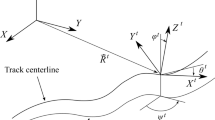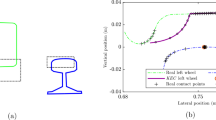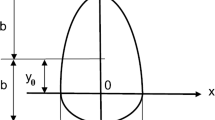Abstract
This paper describes and compares the use and limitations of two constraint-based formulations for the wheel–rail contact simulation in multibody dynamics: (1) the use of contact lookup tables and (2) the Knife-edge Equivalent Contact constraint method (KEC-method). Both formulations are presented and an accurate procedure to interpolate within the data in the lookup table is also described. Since the wheel–rail constraint contact approach finds difficulties at simultaneous tread and flange contact scenarios, the lookup table method is implemented with a penetration-based elastic contact model for the flange, turning the method into a hybrid (constant in the tread and elastic in the flange) approach. To deal with the two-point contact scenario in the KEC-method, a regularisation of the tread–flange transition allows the use of the constraint approach in the tread and also in the flange. To show the applicability and limitations of both methods, they are studied and compared with special emphasis in the calculation of normal and tangential contact forces. Numerical results are based on the simulation of a two-wheeled bogie vehicle in different case studies that consider irregular tracks and two wheel–rail profiles combinations: profiles that do not show two-point wheel–rail contacts and profiles that do show two-point wheel–rail contacts. Although results show a good agreement between both approaches, the use of the KEC-method is more extensive since it allows to reproduce the wheel-climbing scenario that cannot be simulated with the lookup table method with the hybrid contact approach. It is concluded that simulations with this later method may not be on the safe side.































Similar content being viewed by others
Abbreviations
- \(\bar{\mathbf {r}}^{lir}\), \(\bar{\mathbf {r}}^{rir}\) :
-
The relative position vector of the irregular rail centreline with respect to the ideal rail centreline.
- \(\bar{\mathbf {r}}^{lrp}\), \(\bar{\mathbf {r}}^{rrp}\) :
-
The relative position vector of the ideal rail centreline with respect to the the track frame.
- \(\bar{\mathbf {r}}^{wi}_{c}\), \(\bar{\mathbf {r}}^{rp}_{c}\) :
-
The position vectors of contact points on the wheel and rail in track frame.
- \(\bar{\mathbf {t}}^{wi}_{1,c}\), \(\bar{\mathbf {n}}_{c}^{rp}\) :
-
The unit-tangent vector and normal vector at the contact point in track frame.
- \(\beta\) :
-
The orientation angle of the rail profiles
- \(\boldsymbol{\lambda}\) :
-
The array of Lagrange multipliers.
- \(\delta\) :
-
The linearised rotation angle due to the irregularity
- \(\delta^{wi}\), \(\dot{\delta}^{wi}\) :
-
The wheel-rail penetration at the flange contact and its time derivative.
- \(\hat{\mathbf {u}}^{rrp}_{P}\), \(\hat{\mathbf {u}}^{lrp}_{Q}\) :
-
The position vector of points \(P\) and \(Q\) in the rail profiles.
- \(\hat{\mathbf {u}}^{wIi}_{R}\), \(\hat{\mathbf {u}}^{wIi}_{L}\) :
-
The position of the points in the wheel surface with respect to the wheelset intermediate frame.
- \(\mathbf {A}^{t,lrp}\), \(\mathbf {A}^{t,rrp}\) :
-
The rotation matrix from the railhead frame with respect to the track frame.
- \(\mathbf {A}^{t}\) :
-
The rotation matrix from the track frame to the global frame.
- \(\mathbf {A}^{wti,wi}\), \(\mathbf {A}^{wti,wIi}\), \(\mathbf {A}^{wIi,wi}\) :
-
The rotation matrices from wheel frame to the wheelset track frame, from wheelset intermediate frame to the wheelset track frame and from wheel frame to the wheelset intermediate frame.
- \(\mathbf {C}^{clt}\) :
-
The wheel-rail contact constraint equations modelled with lookup tables.
- \(\mathbf {C}^{clt}_{\mathbf {q}}\), \(\dot{\mathbf {C}}^{clt}_{\mathbf {q}}\) :
-
The Jacobian matrix and its time derivative of all wheel-rail contact constraints modelled with lookup tables.
- \(\mathbf {C}^{KEC}\) :
-
The contact constraint equations of a wheelset with KEC profiles.
- \(\mathbf {C}^{KEC}_{\mathbf {q}}\), \(\dot{\mathbf {C}}^{KEC}_{\mathbf {q}}\) :
-
The Jacobian matrix and its time derivative of KEC contact constraint equations with respect to generalised coordinates \(\mathbf {q}\).
- \(\mathbf {C}^{KEC}_{\mathbf {s}}\), \(\dot{\mathbf {C}}^{KEC}_{\mathbf {s}}\) :
-
The Jacobian matrix and its time derivative of KEC contact constraint equations with respect to KEC surface parameters.
- \(\mathbf {n}_{c}^{rp}\) :
-
The normal vector to the rail surface at the contact point in global frame.
- \(\mathbf {Q}\) :
-
The force vectors of generalised applied forces and generalised quadratic-velocity inertia forces.
- \(\mathbf {Q}_{fla}^{nor}\), \(\mathbf {Q}^{tang}\), \(\mathbf {Q}_{tread}^{nor}\) :
-
The force vectors of generalised wheel-rail normal flange forces, generalised tangential tread and flange forces, and generalised normal forces at the wheel tread.
- \(\mathbf {R}^{t}\) :
-
The absolute position vector of an arbitrary point on the ideal track centreline with respect to a global frame.
- \(\mathbf {R}^{wi}_{c}\), \(\mathbf {R}^{rp}_{c}\) :
-
The position vectors of contact points on the wheel and rail in global frame.
- \(\mathbf {t}^{wi}_{1,c}\), \(\mathbf {t}^{wi}_{2,c}\) :
-
The two unit-tangent vectors to the wheel surface at the contact point in global frame.
- \(\psi^{t}\), \(\theta^{t}\), \(\varphi^{t}\) :
-
The Euler angles that describe the orientation of the track frame with respect to a global frame.
- \(al\), \(vp\), \(gv\), \(cl\) :
-
Alignment, vertical profile, gauge variation and cross level.
- \(f^{lk}\), \(f^{rk}\) :
-
The value of the equivalent profiles at the lateral positions of \(s^{lk}\) and \(s^{rk}\).
- \(K_{hertz}\), \(C_{damp}\) :
-
The Hertzian stiffness and the constant that introduces non-linear damping.
- \(L_{w}\) :
-
The lateral distance of the wheel frames with respect to the wheelset frame.
- \(R^{t}_{x}\), \(R^{t}_{y}\), \(R^{t}_{z}\) :
-
The absolute position of an arbitrary point on the ideal track centreline with respect to a global frame in \(X\), \(Y\) and \(Z\) direction.
- \(r_{0}\) :
-
The rolling radius of the wheel when centred in the track.
- \(s\) :
-
The arc-length along the track.
- \(s^{lk}\), \(s^{rk}\) :
-
The lateral positions of the contact point in the left and right KEC profiles.
- \(y^{lir}\), \(z^{lir}\), \(y^{rir}\), \(z^{rir}\) :
-
The track irregularities in \(Y\) and \(Z\) direction.
- \({h}^{r}\), \({h}^{w}\) :
-
The functions that define the railhead and wheel profiles.
- \({s}^{r}_{1}\), \({s}^{r}_{2}\), \({s}^{w}_{1}\), \({s}^{w}_{2}\) :
-
The surface parameters of the railhead and wheel profiles.
- \(\bar{F}^{wi}_{z}\), \(\hat{M}^{wi}_{x}\) :
-
The vertical force and roll torque at the wheelset due to the normal contact forces.
- \(\nu\) :
-
The Poisson’s ratio.
- \(A\), \(B\) and \(\beta_{h}\) :
-
The parameters to compute Hertzian stiffness which depend on the curvatures of rail/wheel surfaces.
- \(E\) :
-
The Young’s modulus of the surface.
References
Bruni, S., Meijaard, J., Rill, G., Schwab, A.: State-of-the-art and challenges of railway and road vehicle dynamics with multibody dynamics approaches. Multibody Syst. Dyn. 49, 1–32 (2020)
Meymand, S.Z., Keylin, A., Ahmadian, M.: A survey of wheel–rail contact models for rail vehicles. Veh. Syst. Dyn. 54(3), 386–428 (2016). https://doi.org/10.1080/00423114.2015.1137956
Shabana, A.A., Tobaa, M., Sugiyama, H., Zaazaa, K.E.: On the computer formulations of the wheel/rail contact problem. Nonlinear Dyn. 40(2), 169–193 (2005). https://doi.org/10.1007/s11071-005-5200-y
Ye, Y., Sun, Y., Dongfang, S., Shi, D., Hecht, M.: Optimizing wheel profiles and suspensions for railway vehicles operating on specific lines to reduce wheel wear: a case study. Multibody Syst. Dyn. 51, 91–122 (2021)
Antunes, P., Magalhães, H., Ambrosio, J., Pombo, J., Costa, J.: A co-simulation approach to the wheel–rail contact with flexible railway track. Multibody Syst. Dyn. 45(2), 245–272 (2019)
Tu, T.W.: Dynamic modelling of a railway wheelset based on Kane’s method. Int. J. Heavy Veh. Syst. 27(1–2), 202–226 (2020)
Shabana, A.A., Zaazaa, K.E., Escalona, J.L., Sany, J.R.: Development of elastic force model for wheel/rail contact problems. J. Sound Vib. 269(1–2), 295–325 (2004). https://doi.org/10.1016/S0022-460X(03)00074-9
Machado, M., Moreira, P., Flores, P., Lankarani, H.M.: Compliant contact force models in multibody dynamics: evolution of the Hertz contact theory. Mech. Mach. Theory 53, 99–121 (2012)
Flores, P., Lankarani, H.M.: Contact Force Models for Multibody Dynamics, vol. 226. Springer, Berlin (2016)
Shabana, A.A., Sany, J.R.: An augmented formulation for mechanical systems with non-generalized coordinates: application to rigid body contact problems. Nonlinear Dyn. 24(2), 183–204 (2001). https://doi.org/10.1023/A:1008362309558
Sugiyama, H., Suda, Y.: On the contact search algorithms for wheel/rail contact problems. J. Comput. Nonlinear Dyn. 4(4), 041001 (2009)
Marques, F., Magalhães, H., Pombo, J., Ambrósio, J., Flores, P.: A three-dimensional approach for contact detection between realistic wheel and rail surfaces for improved railway dynamic analysis. Mech. Mach. Theory 149, 103825 (2020)
Magalhães, H., Marques, F., Liu, B., Antunes, P., Pombo, J., Flores, P., Ambrósio, J., Piotrowski, J., Bruni, S.: Implementation of a non-Hertzian contact model for railway dynamic application. Multibody Syst. Dyn. 48(1), 41–78 (2020)
Sun, Y., Zhai, W., Guo, Y.: A robust non-Hertzian contact method for wheel–rail normal contact analysis. Veh. Syst. Dyn. 56(12), 1899–1921 (2018)
Piotrowski, J., Kik, W.: A simplified model of wheel/rail contact mechanics for non-Hertzian problems and its application in rail vehicle dynamic simulations. Veh. Syst. Dyn. 46(1–2), 27–48 (2008)
Sun, Y., Zhai, W., Ye, Y., Zhu, L., Guo, Y.: A simplified model for solving wheel-rail non-Hertzian normal contact problem under the influence of yaw angle. Int. J. Mech. Sci. 174, 105554 (2020)
Pombo, J., Ambrósio, J., Silva, M.: A new wheel–rail contact model for railway dynamics. Veh. Syst. Dyn. 45(2), 165–189 (2007). https://doi.org/10.1080/00423110600996017
Pombo, J., Ambrósio, J.: Application of a wheel–rail contact model to railway dynamics in small radius curved tracks. Multibody Syst. Dyn. 19, 91–114 (2008). https://doi.org/10.1007/s11044-007-9094-y
Pombo, J., Ambrósio, J.: An alternative method to include track irregularities in railway vehicle dynamic analyses. Nonlinear Dyn. 68, 161–176 (2012). https://doi.org/10.1007/s11071-011-0212-2
O’Shea, J.J., Shabana, A.A.: Analytical and numerical investigation of wheel climb at large angle of attack. Nonlinear Dyn. 83, 555–577 (2016). https://doi.org/10.1007/s11071-015-2347-z
O’Shea, J.J., Shabana, A.A.: Further investigation of wheel climb initiation: three-point contact. Proc. Inst. Mech. Eng., Proc., Part K, J. Multi-Body Dyn. 231(1), 121–132 (2017)
Malvezzi, M., Meli, E., Falomi, S., Rindi, A.: Determination of wheel–rail contact points with semianalytic methods. Multibody Syst. Dyn. 20(4), 327–358 (2008). https://doi.org/10.1007/s11044-008-9123-5
Falomi, S., Malvezzi, M., Meli, E.: Multibody modeling of railway vehicles: innovative algorithms for the detection of wheel–rail contact points. Wear 271(1–2), 453–461 (2011). https://doi.org/10.1016/j.wear.2010.10.039
Baeza, L., Thompson, D.J., Squicciarini, G., Denia, F.D.: Method for obtaining the wheel–rail contact location and its application to the normal problem calculation through ‘CONTACT’. Veh. Syst. Dyn. 56(11), 1734–1746 (2018). https://doi.org/10.1080/00423114.2018.1439178
Muñoz, S., Aceituno, J.F., Urda, P., Escalona, J.L.: Multibody model of railway vehicles with weakly coupled vertical and lateral dynamics. Mech. Syst. Signal Process. 115, 570–592 (2019). https://doi.org/10.1016/j.ymssp.2018.06.019
Escalona, J.L., Aceituno, J.F., Urda, P., Balling, O.: Railway multibody simulation with the knife-edge-equivalent wheel–rail constraint equations. Multibody Syst. Dyn. 48, 373–402 (2020). https://doi.org/10.1007/s11044-019-09708-x
Escalona, J.L., Aceituno, J.F.: Multibody simulation of railway vehicles with contact lookup tables. Int. J. Mech. Sci. 155, 571–582 (2019). https://doi.org/10.1016/j.ijmecsci.2018.01.020
Bozzone, M., Pennestrì, E., Salvini, P.: A lookup table-based method for wheel–rail contact analysis. Proc. Inst. Mech. Eng., Proc., Part K, J. Multi-Body Dyn. 225(2), 127–138 (2011)
Sugiyama, H., Araki, K., Suda, Y.: On-line and off-line wheel/rail contact algorithm in the analysis of multibody railroad vehicle systems. J. Mech. Sci. Technol. 23, 991–996 (2009). https://doi.org/10.1007/s12206-009-0327-2
Sugiyama, H., Sekiguchi, T., Matsumura, R., Yamashita, S., Suda, Y.: Wheel/rail contact dynamics in turnout negotiations with combined nodal and non-conformal contact approach. Multibody Syst. Dyn. 27, 55–74 (2012). https://doi.org/10.1007/s11044-011-9252-0
Piotrowski, J., Liu, B., Bruni, S.: The Kalker book of tables for non-Hertzian contact of wheel and rail. Veh. Syst. Dyn. 55(6), 875–901 (2017)
Marques, F., Magalhães, H., Liu, B., Pombo, J., Flores, P., Ambrósio, J., Piotrowski, J., Bruni, S.: On the generation of enhanced lookup tables for wheel–rail contact models. Wear 434–435, 202993 (2019). https://doi.org/10.1016/j.wear.2019.202993
Piotrowski, J., Bruni, S., Liu, B., Gialleonardo, E.D.: A fast method for determination of creep forces in non-Hertzian contact of wheel and rail base on a book of tables. Multibody Syst. Dyn. 45, 169–184 (2019). https://doi.org/10.1007/s11044-018-09635-3
Santamaría, J., Vadillo, E.G., Gómez, J.: A comprehensive method for the elastic calculation of the two-point wheel–rail contact. Veh. Syst. Dyn. 44(sup1), 240–250 (2006). https://doi.org/10.1080/00423110600870337
Aceituno, J.F., Urda, P., Briales, E., Escalona, J.L.: Analysis of the two-point wheel–rail contact scenario using the knife-edge-equivalent contact constraint method. Mech. Mach. Theory 148, 103803 (2020). https://doi.org/10.1016/j.mechmachtheory.2020.103803
Kalker, J.: Three Dimensional Elastic Bodies in Rolling Contact. Kluwer Academic, Dordrecht (1990)
Polach, O.: Creep forces in simulations of traction vehicles running on adhesion limit. Wear 258(7–8), 992–1000 (2005). https://doi.org/10.1016/j.wear.2004.03.046
Hunt, K., Crossley, E.: Coefficient of restitution interpreted as damping in vibroimpact. J. Appl. Mech. 7, 440–445 (1975)
Shabana, A.A., Zaazaa, K.E., Sugiyama, H.: Railroad Vehicle Dynamics: A Computational Approach. CRC Press, Boca Raton (2007)
Goldsmith, W.: Impact-the Theory and Physical Pehaviour of Colliding Solids. Edward Arnold, London (1960)
Ascher, U.M., Petzold, L.R.: Computer Methods for Ordinary Differential Equations and Differential-Algebraic Equations, vol. 61. SIAM, Philadelphia (1998)
Polach, O.: A fast wheel-rail forces calculation computer code. Veh. Syst. Dyn. 33(sup1), 728–739 (1999). https://doi.org/10.1080/00423114.1999.12063125
Claus, H., Schiehlen, W.: Modeling and simulation of railway bogie structural vibrations. Veh. Syst. Dyn. 29, 538–552 (1998). https://doi.org/10.1080/00423119808969585
Acknowledgements
The first and third authors thank the Department of Economy, Science, Enterprise and University of the Andalusian Regional Government, in Spain, under the PAIDI 2020 program with project reference P18-RT-1772. The second author thanks for the support given by Business of Finland under the SmartTram-LUT project with reference 6292/31/2018. All this support is gratefully acknowledged.
Author information
Authors and Affiliations
Corresponding author
Ethics declarations
Conflict of interest
The authors declare that there is no conflict of interest to this work.
Additional information
Publisher’s Note
Springer Nature remains neutral with regard to jurisdictional claims in published maps and institutional affiliations.
Rights and permissions
About this article
Cite this article
Escalona, J.L., Yu, X. & Aceituno, J.F. Wheel–rail contact simulation with lookup tables and KEC profiles: a comparative study. Multibody Syst Dyn 52, 339–375 (2021). https://doi.org/10.1007/s11044-020-09773-7
Received:
Accepted:
Published:
Issue Date:
DOI: https://doi.org/10.1007/s11044-020-09773-7




